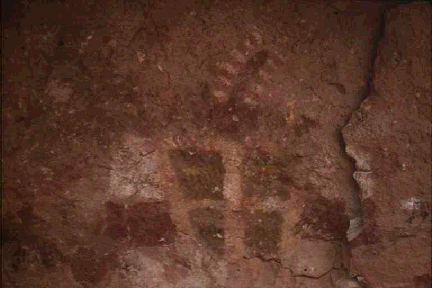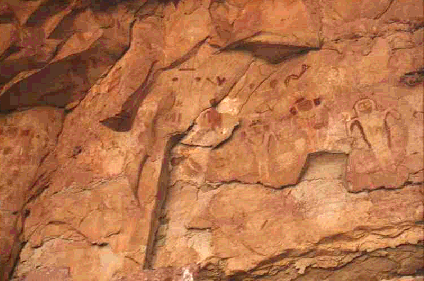 The Grand Canyon is one of the most challenging places to visit rock art sites. There were dozens if not hundreds of routes which Indians would use to cross the canyon-none of them easy. In much of the canyon water is scarce and the summer temperatures are brutal. Crossing the river is no piece of cake. Distances are great. Somehow they found one of the most hostile, forbidding places in the world a nice place to live. Of the multiple rock art traditions that have touched the canyon I will touch on one that I've seen the most- the Snake Gulch Style.
The Grand Canyon is one of the most challenging places to visit rock art sites. There were dozens if not hundreds of routes which Indians would use to cross the canyon-none of them easy. In much of the canyon water is scarce and the summer temperatures are brutal. Crossing the river is no piece of cake. Distances are great. Somehow they found one of the most hostile, forbidding places in the world a nice place to live. Of the multiple rock art traditions that have touched the canyon I will touch on one that I've seen the most- the Snake Gulch Style. At some later date I may attempt to add to this page with a discussion of some of the canyons other styles which are almost too many to list: the Grand Canyon Polychrome Style, the Cave Valley Style, The G.C. Transitional Style, the Glen Canyon Linear Style, the Cohonina Style, and the Paiute style to name a few. Some sites don't fit in well with any styles that have been described in the literature yet. At some later date I may attempt to add to this page with a discussion of some of the canyons other styles which are almost too many to list: the Grand Canyon Polychrome Style, the Cave Valley Style, The G.C. Transitional Style, the Glen Canyon Linear Style, the Cohonina Style, and the Paiute style to name a few. Some sites don't fit in well with any styles that have been described in the literature yet.
Polly Schaafsma was the first person that I'm aware of to mention the Snake Gulch Style in her "Indian Rock Art of the Southwest". She described it in one paragraph- describing all the rock art of the southwest is a gargantua job and few authors could have done so as succinctly and as fluidly as she did. She identifies it as being from the Basketmaker 2 periond. She props the Snake Gulch Style up at the start by saying these are 'spectacular figures' and then disses them by saying they are 'rather crudely painted in two colors'. Why I would dis one of the most solid authors in rock art is beyond me, but I've seen at least three colors in several anthros (what a jerk I am) and have been impressed by the multitude of colors and hues with which these anthros have been portrayed and by the craftsmanship with which they were created. Regrettably, my photos did not scan well and don't do these sites justice. Here is a sampling of some of these figures. She described it in one paragraph- describing all the rock art of the southwest is a gargantua job and few authors could have done so as succinctly and as fluidly as she did. She identifies it as being from the Basketmaker 2 periond. She props the Snake Gulch Style up at the start by saying these are 'spectacular figures' and then disses them by saying they are 'rather crudely painted in two colors'. Why I would dis one of the most solid authors in rock art is beyond me, but I've seen at least three colors in several anthros (what a jerk I am) and have been impressed by the multitude of colors and hues with which these anthros have been portrayed and by the craftsmanship with which they were created. Regrettably, my photos did not scan well and don't do these sites justice. Here is a sampling of some of these figures.

CONTENTS
BACK
NEXT
Send e-mail to c395smith@hotmail.com
|

 At some later date I may attempt to add to this page with a discussion of some of the canyons other styles which are almost too many to list: the Grand Canyon Polychrome Style, the Cave Valley Style, The G.C. Transitional Style, the Glen Canyon Linear Style, the Cohonina Style, and the Paiute style to name a few. Some sites don't fit in well with any styles that have been described in the literature yet.
At some later date I may attempt to add to this page with a discussion of some of the canyons other styles which are almost too many to list: the Grand Canyon Polychrome Style, the Cave Valley Style, The G.C. Transitional Style, the Glen Canyon Linear Style, the Cohonina Style, and the Paiute style to name a few. Some sites don't fit in well with any styles that have been described in the literature yet.
 She described it in one paragraph- describing all the rock art of the southwest is a gargantua job and few authors could have done so as succinctly and as fluidly as she did. She identifies it as being from the Basketmaker 2 periond. She props the Snake Gulch Style up at the start by saying these are 'spectacular figures' and then disses them by saying they are 'rather crudely painted in two colors'. Why I would dis one of the most solid authors in rock art is beyond me, but I've seen at least three colors in several anthros (what a jerk I am) and have been impressed by the multitude of colors and hues with which these anthros have been portrayed and by the craftsmanship with which they were created. Regrettably, my photos did not scan well and don't do these sites justice. Here is a sampling of some of these figures.
She described it in one paragraph- describing all the rock art of the southwest is a gargantua job and few authors could have done so as succinctly and as fluidly as she did. She identifies it as being from the Basketmaker 2 periond. She props the Snake Gulch Style up at the start by saying these are 'spectacular figures' and then disses them by saying they are 'rather crudely painted in two colors'. Why I would dis one of the most solid authors in rock art is beyond me, but I've seen at least three colors in several anthros (what a jerk I am) and have been impressed by the multitude of colors and hues with which these anthros have been portrayed and by the craftsmanship with which they were created. Regrettably, my photos did not scan well and don't do these sites justice. Here is a sampling of some of these figures.
